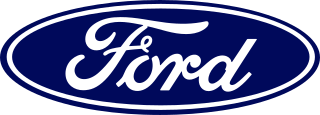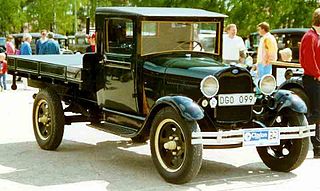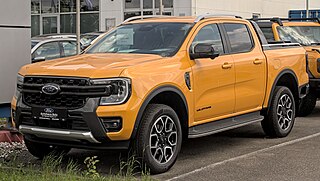Related Research Articles

British Leyland was an automotive engineering and manufacturing conglomerate formed in the United Kingdom in 1968 as British Leyland Motor Corporation Ltd (BLMC), following the merger of Leyland Motors and British Motor Holdings. It was partly nationalised in 1975, when the UK government created a holding company called British Leyland, later renamed BL in 1978. It incorporated much of the British-owned motor vehicle industry, which in 1968 had a 40% share of the UK car market, with its history going back to 1895. Despite containing profitable marques such as Jaguar, Rover, and Land Rover, as well as the best-selling Mini, BLMC had a troubled history, leading to its eventual collapse in 1975 and subsequent part-nationalisation.
The Rover Group plc was the British vehicle manufacturing conglomerate known as "BL plc" until 1986, which had been a state-owned company since 1975. It initially included the Austin Rover Group car business, Land Rover Group, Freight Rover vans and Leyland Trucks. The Rover Group also owned the dormant trademarks from the many companies that had merged into British Leyland and its predecessors such as Triumph, Morris, Wolseley, Riley and Alvis.

Ford Motor Company of Australia Limited is the Australian subsidiary of United States-based automaker Ford Motor Company. It was founded in 1925 as an Australian outpost of Ford Motor Company of Canada. At that time, Ford Canada was a separate company from Ford in the US. Henry Ford had granted the manufacturing rights of Ford motor vehicles in the British Empire to Canadian investors.
New United Motor Manufacturing, Inc. (NUMMI) was an American automobile manufacturing company in Fremont, California, jointly owned by General Motors and Toyota that opened in 1984 and closed in April 2010.
Freightliner Trucks is an American semi truck manufacturer. Founded in 1929 as the truck-manufacturing division of Consolidated Freightways, the company was established in 1942 as Freightliner Corporation. Owned by Daimler AG from 1981 to 2021, Freightliner is now a part of Daimler Truck subsidiary Daimler Truck North America.

Auto Alliance Co., Ltd. or AutoAlliance Thailand (AAT) is the name of a joint venture automobile assembly firm co-owned by Ford and Mazda in Rayong province, Thailand. Modeled after the Ford-Mazda AutoAlliance International joint venture in the United States, AAT builds compact pickup trucks and SUVs primarily for the Southeast Asian market, with exports to Australia and other developing markets as well.

The Highland Park Ford Plant is a former Ford Motor Company factory located at 91 Manchester Street in Highland Park, Michigan. It was the second American production facility for the Model T automobile and the first factory in history to assemble cars on a moving assembly line. It became a National Historic Landmark in 1978.

Willow Run, also known as Air Force Plant 31, was a manufacturing complex in Michigan, United States, located between Ypsilanti Township and Belleville, built by the Ford Motor Company to manufacture aircraft, especially the Consolidated B-24 Liberator heavy bomber. Construction of the Willow Run Bomber Plant began in 1940 and was completed in 1942.

Ford Group Philippines, Inc. (FGPI) is a Philippine-based subsidiary of Ford Motor Company. It was primarily focused on manufacturing automobiles for local and regional markets from 1998 until 2012. It built the Ford Escape, Ford Laser/Lynx, Ford Focus, Mazda3, and Mazda Tribute for the Philippines, Thailand, Indonesia, Singapore, Malaysia and Vietnam. Since 2012, Ford Philippines imports the vehicles it sells to the Philippine market. These imports come mostly from Thailand and the United States.

The Ford River Rouge complex is a Ford Motor Company automobile factory complex located in Dearborn, Michigan, along the River Rouge, upstream from its confluence with the Detroit River at Zug Island. Construction began in 1917, and when it was completed in 1928, it was the largest integrated factory in the world, surpassing Buick City, built in 1904.
Ford Otomotiv Sanayi A.Ş., doing business as Ford Otosan, is an automotive manufacturing company based in Turkey that is equally owned by Ford Motor Company and Koç Holding. The company was established in its current form in 1977, with original relations dating back to 1928. It currently operates in six locations: Gölcük and Yeniköy plants in Kocaeli, İnönü plant in Eskişehir, Craiova plant in Romania, Sancaktepe R&D Center and spare parts warehouse in Istanbul The company employs more than 20,000 people and had a production capacity of over 700,000 vehicles, 400,000 engines, and 140,000 powertrains by 2022.

The Twin Cities Assembly Plant was a Ford Motor Company manufacturing facility in Saint Paul, Minnesota, United States, that operated from 1925 to 2011. In 1912, Ford's first assembly and sales activities in Minnesota began in a former warehouse in Minneapolis. By 1925, Ford had relocated its local operations to the bluffs above the Mississippi River in the Highland Park neighborhood of Saint Paul. In 2006, Ford officials announced plans to close the factory, though it operated for three years past the 2008 closure date initially announced. At the time of its closure, it was the oldest Ford plant in continuous operation. The plant's final truck was completed on December 16, 2011. All of the facility's buildings were demolished and the site underwent extensive environmental remediation in the late 2010s, paid for by Ford. Following a multi-year planning and community engagement process, the site was sold to the Ryan Companies, who began redevelopment of the site in 2020 as Highland Bridge, a 122-acre residential and commercial district.

Ford Motor Company Limited, trading as Ford of Britain, is a British wholly owned subsidiary of Ford Technologies Limited, itself a subsidiary of Ford International Capital LLC, which is a subsidiary of Ford Motor Company. Its business started in 1909 and has its registered office in Laindon, Essex. It adopted the name of Ford of Britain in 1960.

Ford Model AA is a truck from Ford. As the Model T and TT became obsolete and needed to be replaced, Henry Ford began initial designs on the Model A and Model AA in 1926. Basic chassis layout was done rapidly and mechanical development was moved forward quickly. Body design and style was developed and then outsourced to various body manufacturers, including Briggs and Murray. The designs of the Model A shared parts and materials with the Model AA Ford, notably the body, engine and interior. The AA usually received plainer interiors than their car counterparts. The Model AA followed similar design changes to the Model A during the AA's four years in production, often delayed anywhere from three to nine months. The mechanical changes and upgrades were done during production of the vehicles. Body changes that occurred between 1929 and 1930 were also integrated into AA production, but leftover parts were used longer in the heavy commercial trucks.

Since 2009, the United States is home to the second largest passenger vehicle market of any country in the world, second to China. Overall, there were an estimated 263.6 million registered vehicles in the United States in 2015, most of which were passenger vehicles. This number, along with the average age of vehicles, has increased steadily since 1960. The United States is also home to three large vehicle manufacturers: General Motors, Ford Motor Company, and Chrysler, which have historically been referred to as the "Big Three".

Ford-Werke GmbH is a German-based car manufacturing factory headquartered in Merkenich- Cologne, North Rhine-Westphalia. It is a fully owned subsidiary of American Ford Motor Company, which operates two large manufacturing facilities in Germany, a plant in Cologne and a plant in Saarlouis and serves as a major hub for the Automaker's presence in the European markets.

A substantial car industry was created in Australia in the 20th century through the opening of Australian plants by international manufacturers. The first major carmaker was Ford Australia and the first Australian-designed mass production car was manufactured by Holden in 1948. Australian manufacture of cars rose to a maximum of almost half a million in the 1970s and still exceeded 400,000 in 2004. Australia was best known for the design and production of 'large' sized passenger vehicles. By 2009 total production had fallen to around 175,000 and the Australian market was dominated by cars imported from Asia and Europe.

The Ford Ranger is a compact or mid-size pickup marketed globally by Ford over a series of generations, varying between both in-house or outside development and manufacturing — and with a hiatus in North America from 2011–2018.

Ford Motor Company is an American multinational automobile manufacturer headquartered in Dearborn, Michigan, United States. It was founded by Henry Ford and incorporated on June 16, 1903. The company sells automobiles and commercial vehicles under the Ford brand, and luxury cars under its Lincoln brand. The company is listed on the New York Stock Exchange and is controlled by the Ford family. They have minority ownership but the majority of the voting power.

As of 2019, the automotive industry in Thailand is the largest in Southeast Asia and the 10th largest in the world. The Thai industry has an annual output of more than two million vehicles, more than countries such as Belgium, Canada, the United Kingdom, Italy, Czech Republic and Turkey.
References
- 1 2 3 4 5 6 7 "Despite Ford's troubles, Norfolk plant is likely to keep on truckin'". Jeremiah McWilliams, The Virginian-Pilot© November 11, 2005. Archived from the original on August 11, 2007. Retrieved April 11, 2008.
- ↑ "Ford Sells Norfolk Assembly Plant". Autoblog, 18 Mar 2011, Daniel Patrascu.
- ↑ "Joy Ride. Ford unions met resistance, brought relief". Virginian-Pilot, March 26, 2007, Bill Burke.
- 1 2 "Local Ford plant not on reported closing list". The Virginian Pilot, December 3, 2005.
- ↑ "Albert Kahn Papers, 1896-2011". Bentley Historical Library.
- ↑ "Joy Ride. School bus frames were a staple at Norfolk Ford plant". Virginian-Pilot, March 28, 2007, Bill Burke.
- ↑ "Back in the Day, December 1915". Virginian-Pilot, December 9, 2018.
- 1 2 3 "Joy Ride. Part 1 of 7: Plant Opens in 1925". Virginian-Pilot, March 25, 2007, Bill Burke.
- ↑ "FORD'S CAR OUTPUT 1,200 TO 1,500 DAILY". New York Times, March 23, 1928.
- ↑ "Joy Ride. Part 3 of 7: Navy took over Ford plant during war". Virginian-Pilot, March 25, 2007, Bill Burke.
- 1 2 "Ford worker to get last truck off Norfolk's assembly line". Philip Walzer, The Virginian-Pilot© June 6, 2007.
- 1 2 "Ford Plant in Norfolk Closes". The Washington Post©, June 28, 2007. June 28, 2007. Retrieved May 20, 2010.
- ↑ "Ford Sells Plant in Virginia". Edmunds, Michelle Krebs, March 21, 2011.
- ↑ "3 parcels of old Norfolk Ford plant sold". WVEC.cm, February 12, 2014.
- 1 2 3 "Belgian firm to use Norfolk Ford plant for warehousing". Virginian Pilot, Josh Brown, March 19, 2011.
- ↑ "New business at old Ford plant off to slow start". Virginian Pilot, Josh Brown, April 29, 2012.
